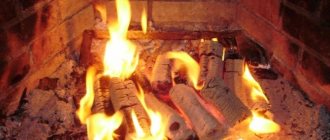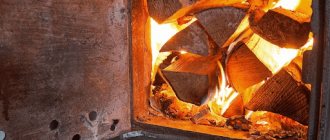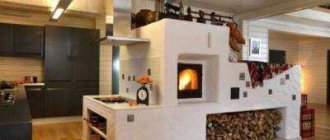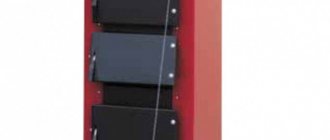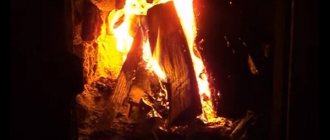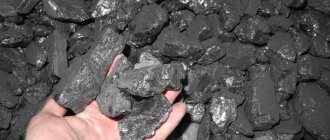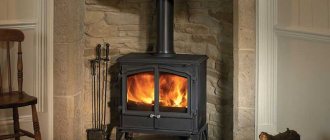Not long ago, an alternative fuel for lighting stoves appeared - fuel briquettes, which are positioned as an analogue of conventional firewood, but with better calorific characteristics. In order not to be unfounded, we decided to compare the capabilities of wood and European firewood, evaluate their technical characteristics, nuances of use and determine whether fuel briquettes or firewood are better for the consumer, which is more profitable.
Comparing firewood and fuel briquettes
Advantages and disadvantages of artificial fuel
Eurofirewood got its name because of its regular geometric shape and is an alternative type of solid fuel (wood or coal). They are convenient for heating stoves, fireplaces, and using for solid fuel boilers and other types of heating appliances. In order to decide which type of fuel to give preference to, you should consider all the advantages and disadvantages of briquettes over firewood. To produce briquettes, waste from the food and wood processing industries is used. They include:
- sawdust;
- husks of cereals (rice, buckwheat) and industrial crops (sunflower);
- peat;
- straw.
The compressed briquette holds its shape due to the physical properties of the components included in its composition.
Ideal drying of the fuel material determines good combustion, compact and aesthetic appearance. No glue is used in the production of briquettes, so such products are environmentally friendly and safe for humans.
Types of Eurobriquettes
Fuel briquettes come in two types, but the difference between them is not too great:
Eurobriquettes RUF
Fuel briquettes from Kuf wood waste
They are made using the technology described above: wood chips and sawdust are pressed together and held together with a natural adhesive. They have the shape of a rectangle. The most optimal option, since they are inexpensive, but the price does not affect the quality in any way.
Eurobriquettes Pini-key
Pini-Kay fuel briquettes
are made according to the same principle, but at the final stage they also undergo a firing process. As a result, Eurobriquettes of this type acquire natural protection from moisture, which guarantees their longer storage.
Due to this, the price of such firewood is higher: the markup is about two thousand rubles per ton. Outwardly, they also do not look like RUF: these firewood have a shape close to an ordinary log, with a through hole.
DIY briquette press
Why are briquettes better?
Their main advantage over firewood is their affordable price and high heat output. For example, the heat transfer of firewood at a humidity of 20% is about 3000 kcal/kg, and a briquette is 5000 kcal/kg. Compared to firewood, the moisture level of briquettes is 3-4 times lower, this is achieved due to the fact that they are almost completely dried. High density ensures excellent heat transfer; they also emit less soot and ash and do not pollute the chimney; they burn evenly, which is achieved due to a uniform and homogeneous structure.
Pressed products take up less space, are compact, and if you compare what is better for heating - firewood or fuel briquettes, then it is worth considering the disadvantages of each type of fuel.
Artificial firewood is sensitive to moisture, they are more expensive and very often the quality does not meet standards.
It is very difficult to visually distinguish between a good briquette and a low-quality briquette, since it is simply impossible to determine its composition externally. Soft wood waste and low-quality wood can be added to briquettes, which as a result significantly reduces heat transfer.
Heating with regular wood
Firewood has been used for heating for a very long time; it is a high-quality fuel for the home and bathhouse, barbecue and barbecue. The environmental friendliness of firewood will always be 100%, and this fuel has plenty of other advantages. Let us note the main advantages of firewood, without delving deeply into this topic:
- First of all, I would like to say that the process of harvesting, drying and storing firewood is understandable to everyone. From an early age we know how to look for firewood, collect and light it.
- Lighting wood is not difficult, even when it is damp. Some tree varieties can burn in high humidity, giving off heat.
- The cost of firewood is low, even if you do not go through the entire harvesting cycle, but buy ready-made logs or logs. (However, until the prices of different types of fuel are compared, it will not be possible to say which is more profitable.)
- Firewood is not afraid of mechanical damage and can be stored in a woodpile in completely different ways.
- From an aesthetic point of view, the wood burns perfectly. They create a beautiful fire and soulful crackle, and when some varieties burn, a characteristic pleasant aroma appears. For open fireplaces, where the appearance of what is happening is important, this fuel is considered optimal.
- The substances released during the combustion of wood have a beneficial effect on humans, they calm the nervous system and heal the respiratory system.
Strategic forest reserve for winter
We will also highlight the disadvantages of natural fuel:
- To obtain high heat transfer, the firewood should be well dried under natural conditions, which requires an extremely long time, for example, 1 or 2 years. The best firewood is wood that has lain in a dry shed for a couple of years.
- During long-term storage, wood loses some of its qualities, especially fragrant varieties of trees.
- Firewood takes up a lot of space; for its normal storage in the required quantity, it is necessary to build an appropriate structure.
- When using firewood, a lot of debris always appears (chips, bark, wood dust, sawdust).
Good to know: Fuel briquettes made from sunflower seeds and husks, general overview
Having become acquainted with the main capabilities of the two types of fuel, let's make a comparison.
Features of solid fuel
Coal can be used to heat rooms. Despite the fact that this type of fuel is the most ancient, it uses the same equipment as for firewood. The heating works on the same principle as a classic stove.
Unlike the latter, the room with solid fuel boilers is heated not by the heat from the flame, but by the water heating system.
While maintaining the required temperature in the system, frequent changes may occur due to uneven combustion of fuel. A stable temperature can be ensured with briquettes that burn evenly and have high heat transfer.
What is better to choose regular firewood or “euro”?
Fuel briquettes, like any manufactured product, have both their positive and negative sides. Compared to firewood, briquettes boast the following advantages:
- They burn on average 4 times longer than conventional firewood, which allows them to be consumed in much smaller quantities.
- They literally burn to ash, leaving behind it in the amount of 1% of the original mass of the material. By the way, after burning wood, coal remains, amounting to about 20% of the initial amount of material. By the way, the ash from burnt European firewood can be used as a fertilizer for the soil: seedlings in this place will grow better due to the increased amount of potassium.
- The heat transfer of Euro-doors is significantly higher than that of conventional ones: the difference is 2 times.
- Capable of maintaining heat literally throughout the entire combustion process. That is, if with ordinary firewood the heating power decreases as it burns, and the coals die out within 15 minutes, then with European firewood the level of heat transfer does not change even when only coals are left from the briquette, which continue to burn for another hour. This property is extremely useful for those who like to go outdoors with a barbecue.
- The fire from burning briquettes does not spark, and practically does not emit smoke or odor. Thus, Euro firewood does not harm the environment and does not cause discomfort when being near it.
- When burned, Eurowood does not emit substances that are harmful and dangerous to human health. The fact is that ordinary firewood contains fungi and mold, which die when burned, but create toxic smoke.
- As a result of burning fuel briquettes, soot does not form on the walls of the chimney.
Table of ignition temperature of fuel materials
- The compactness of briquettes allows you to significantly save on space: they are delivered in the form of neatly stacked stacks. Firewood can be of different shapes and sizes, which makes it almost impossible to stack them neatly. Moreover, the firewood is usually “dumped” out of the truck onto any free space on the site, after which you will have to carry it to the shed yourself and lay it out there.
In general, all the positive aspects of fuel briquettes could be summed up in one word: efficiency. Although, there are several points that favorably distinguish fuel briquettes from ordinary firewood that have nothing to do with price. For example, one of the very big advantages is cleanliness and order. Conventional firewood produces a lot of dust, chips and other debris. Briquettes do not have such difficulties. However, does this mean that briquettes are definitely better than firewood?
What fuel should I use in my stove?
An important factor for maintaining a constant temperature is the correct choice of long-burning stoves, which are refueled periodically and the fuel in them burns much longer. Owners of country houses or summer cottages can use artificial firewood to heat their premises, but it is convenient to use briquettes to light a fireplace. To do this, it is better to place them on paper and birch bark, which will speed up the ignition process. In the same way, you can use firewood, which does not always light well. To prevent soot from remaining as sediment in the chimney, it is recommended to throw a pinch of table salt into the fire with each addition.
So which is better?
Considering the above, we can highlight the main advantages that fuel briquettes have - high burning time, saving storage space, lack of garbage, safety for the environment and a more affordable price compared to conventional firewood. But if you are not ready to deprive yourself of the opportunity to enjoy the crackle of burning dry birch logs, then you will not experience much benefit from buying Euro firewood. In addition, briquette fuel will not help you warm up the room as quickly as firewood.
It follows that when choosing fuel, you must first take into account both the characteristics and positive aspects of each product, as well as the purposes for which you intend to use them.
Fuel for the fire
If you need to create a special atmosphere with the help of a beautiful flame in the fireplace, then a wood fire is ideal, the flame from which is much larger and very beautiful. It is worth keeping in mind that birch firewood will burn best due to the oils contained in the wood.
Birch is a hard tree, so the density of the firewood is higher, which has a positive effect on heat transfer.
When heating a fireplace with briquettes, it is better to place them vertically, then the flames rush upward. Briquettes, unlike firewood, burn longer and more evenly, and this is ideal for a long-burning boiler and is inferior to using them for an open fire.
Comparison
So, both firewood and fuel briquettes have their own advantages and disadvantages. Therefore, it is worth choosing the right fuel.
| Characteristic | Fuel briquettes | Firewood |
| Price | Relatively high | Relatively low, and when harvesting with one’s own hands – almost zero |
| Heat dissipation | Always high | Depends on the variety and quality of drying. In most cases - high |
| Burning time | 2-4 hours | 1-2 hours |
| Combustion type | Hot smoldering | Rapid combustion with open flames |
| Storage conditions | Dry, closed place | Dry, ventilated place |
| Risk of contact with water | They quickly absorb moisture, after which they crumble and become unusable | Become susceptible to the action of pests and fungi |
| Smoke quantity | Minimum | Depends on the variety and quality of drying, but usually a large |
| Ash quantity | Big | Average |
It is worth noting that with equal temperature distribution, fuel briquettes burn 2-4 times better than firewood. That is why they are more economical.
However, the unpleasant smell of burning and the absence of open flames make fuel briquettes unsuitable for use in fireplaces and stoves located directly in residential premises. For such fireplaces it is better to use firewood.
The question is the price!
The cost of fuel briquettes can vary depending on their quality. They can be divided into two groups:
- Briquettes of the highest quality. They are characterized by high density: 1400 kg per cubic meter. They burn longer, give off more heat and leave a minimum of ash. They have a dense structure without cracks.
- Briquettes of normal quality. Their density is about 1000 kg per cubic meter, have a layered structure and are more susceptible to damage. In addition, they have less heat transfer, burn out faster and leave behind more sediment.
The difference in quality and price comes from the manufacturer’s costs for equipment: the more the briquette is pressed, the better quality it will be and the faster the machine on which it is made wears out. This factor of rapid wear and tear is included in the cost of the product.
Comparison of the cost of briquettes with firewood
Obviously, high quality briquettes will cost more than regular briquettes. But at the same time, even briquettes of the highest quality will cost less than ordinary birch firewood, and even more so of ordinary quality.
If they seem too expensive, even taking into account the savings compared to firewood, you can make them yourself. To do this, you will need to collect all the branches and twigs from the site, mix them with clay and fill them with water. There should not be too much water so that bars can be formed as a result.
The resulting mixture is poured into molds, compressed and left to dry in the sun for several days. Of course, such a product will be significantly inferior to real briquettes, but it will save money. In addition, the area will become cleaner.
What are briquettes for heating?
Waste from the wood processing, agricultural and food industries is used as solid fuel. Sawdust, wood shavings, husks, straw, and pine needles are pressed under high pressure. They use only natural raw materials. The binding element is lignin, which is released under a press with heating or at normal temperature. When heated, the surface of the briquettes melts and becomes more durable. The humidity of briquettes is 5 - 6 times less than the humidity of ordinary firewood. Briquettes for heating are called eco-firewood due to the absence of chemicals in them.
In Europe, and throughout the world, owners of country houses are eager to buy fuel briquettes for heating. In Russia, with its forests and developed woodworking industry, there are favorable conditions to develop the production of fuel briquettes. Wood waste is considered a high-quality raw material; during combustion, the greatest amount of heat is released and the least amount of ash is formed. Biofuel made from tree bark without other additives can burn, or rather smolder, for 10 to 12 hours. However, during production the raw materials have to be crushed and dried.
How much are?
The price of briquettes for heating a furnace depends on the technology and material from which the product is made.
- Alternative fuel of the Pini-kay type made from pine needles will cost an average of 8,900 rubles. for one ton, from birch - from 9,500 rubles.
- RUF briquettes are cheaper: sawdust 6500, pine needles 6000, pine and birch 6500, birch 6900 rubles.
- Nestro briquettes are the most inexpensive: 7500 per ton. Peat briquettes will cost the stove owner 8,000 rubles, and coal briquettes – 9,500 rubles.
You can purchase briquettes in specialized stores, as well as on websites on the Internet. Online shopping will be a little more profitable, since you will not have to pay for the services of consultants and renting store premises. But in the store you can personally see the quality of such a purchase, which is very difficult to do via the Internet.
The cheaper way to heat your home
The price of fuel for heating a private home is of great importance, but it is pointless to consider it in isolation from heat transfer. We will calculate the cost of heating taking into account both parameters.
Combustion of peat fuel 3 hours after laying
In the area where our expert lives, the following prices are asked for proven types of fuel:
- Freshly cut firewood – 20 USD. e. for 1 m³. Let's tie the price to the weight: 20 dollars for 600 kg or 33 cu. e. for 1 ton.
- Briquettes made from pressed sunflower husks – $57 per ton.
- Peat briquette – 84 USD. e./1 t.
It is easy to calculate that 10 kg of wood will cost 33 cents, the rest of the fuel - 57 and 84 cents, respectively. Then 1 hour of heating on wooden logs costs 33 / 1.5 = 22 cents (remember, the wood burned out in an hour and a half).
In a similar way, we determine the hourly rate for burning briquettes:
- pressed husk: 57 / 2.17 (2 hours 10 minutes) = 26 cents;
- briquetted peat: 84 / 3 = 28 cents.
Burning briquetted sunflower seed husks.
Interesting result, right? In our case, heating up an absolutely cold building costs 5.28 USD. e. per day for wood, 6.24 dollars for pressed husks and 6.72 cu. e. - on peat “bricks”.
An important nuance. The prices of solid fuel in your region are probably different, and the boiler room has different heating equipment. But the ratio and principle of calculation remain unchanged. Apply this technique and consider what is more profitable - firewood or briquettes in your particular case.
Please note that we took the cost of raw wood (and it will decay sooner) and divided it by the time of full combustion of dry wood. That is, the difference between traditional fuel and briquettes is minimized. We invite you to track the progress of the experiment on video and listen to an expert’s opinion on this matter.


